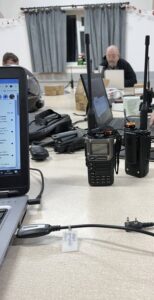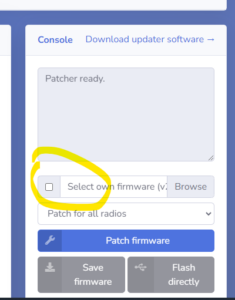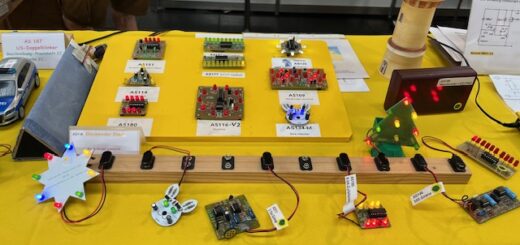Exploring the Quansheng UV-K5(8)
Exploring the Quansheng UV-K5(8)
(Please Note, this is experimental firmware, if you follow the information below, you do so at your own risk. We don’t accept any liability for any damage caused).
 “Exploring the Quansheng UV-K5(8): In the latter half of 2023, the ham radio community has shown significant interest in the Quansheng UV-K5(8) handheld radio. We’ve acquired one for review, and this page is an update as we delve into its features.
“Exploring the Quansheng UV-K5(8): In the latter half of 2023, the ham radio community has shown significant interest in the Quansheng UV-K5(8) handheld radio. We’ve acquired one for review, and this page is an update as we delve into its features.
Discover the Quansheng UV-K5:
- Affordable entry-level radio (Starting from £10!)
- 2m and 70cm transmission up to 5 watts
- Receives FM broadcast and airband
- Dual watch/scan functionality
- USB charging for emergencies
- PC programmable
- Exciting potential for modifications
Purchasing Experience:
Motivated by positive discussions within our group, we secured a Quansheng UV-K5 from AliExpress for an unbelievable £10.69, including shipping. Initial impressions reveal a comfortable hold, with a familiar Baofeng-like menu structure and a larger, more readable screen than the UV-5R. When purchasing please keep in mind Caveat emptor “buyer beware”.
Unlocking Possibilities:
What sets the UV-K5 apart is the ability to re-flash its firmware, offering access to additional features. Caution is advised, as the stock firmware is user-friendly. For those curious to explore, a Baofeng programming lead is recommended, and the EGZUMER firmware is gaining popularity.
Flashing Instructions:
- Connect the USB lead to the radio
- Hold down PTT and switch on the radio
- From the Chrome browser, select the USB icon, choose the correct port, and press “Flash Firmware”
Enhanced Features Post-Flash:
- Extended frequency range: 18 MHz to 660 MHz, and 840 to 1.3 GHz
- Selectable FM, AM, and SSB
- Improved meters and signal reporting
- Enhanced AM reception for airband
- Battery percentage display
- Improved squelch and longer backlight time
- Spectrum analyzer feature for advanced users
Fun Discovery:
The Spectrum Analyzer reveals the entire 2m band with customizable settings. Developer updates indicate ongoing improvements, with 20 firmware releases between September and November 2023. As we navigate this intriguing journey, stay tuned for more insights into the Quansheng UV-K5’s capabilities and limitations.”
We got a bin file from the UK Quansheng Facebook group, https://www.facebook.com/groups/2291286734508728
Using the UVMOD web page we uploaded the firmware having first unticked the box, using stock firmware on the right side of the page. https://whosmatt.github.io/uvmod/
We used the Eqzumer firmware more information about that can be found at https://github.com/egzumer/uv-k5-firmware-custom
Ben M7FRS (not a member) has produced an excellent video which can be found on YouTube at https://www.youtube.com/watch?v=kZ1i7YP05hQ
Have fun and enjoy your Quansheng uv-k5.
Experimentation: The Cornerstone of Amateur Radio
Experimentation lies at the heart of amateur radio, driving innovation, discovery, and technical advancement. Since the earliest days of radio communication, amateur operators—often referred to as hams—have been at the forefront of testing new technologies, refining transmission methods, and expanding the boundaries of what is possible.
One of the most exciting aspects of amateur radio is its hands-on approach to learning. Operators build and modify antennas, experiment with different frequencies, and test new digital modes, all in the pursuit of better communication. Many groundbreaking advancements in radio technology, including early developments in single-sideband (SSB), packet radio, and weak-signal digital modes like FT8, have originated from amateur radio experimentation.
Beyond technical innovation, experimentation strengthens problem-solving skills. Whether setting up a low-power QRP station, testing propagation conditions, or troubleshooting interference, hams constantly apply creativity and ingenuity to overcome challenges.
Regulatory bodies such as the FCC (USA) and Ofcom (UK) recognize amateur radio as a “self-training service”, allowing operators to explore new technologies with relatively few restrictions. This freedom enables amateurs to contribute to scientific research, emergency communications, and even space exploration—such as contacts made with the International Space Station (ISS).
At its core, amateur radio is about curiosity, learning, and pushing technological limits. Experimentation ensures the hobby remains dynamic, relevant, and an essential part of the ever-evolving world of communications.



